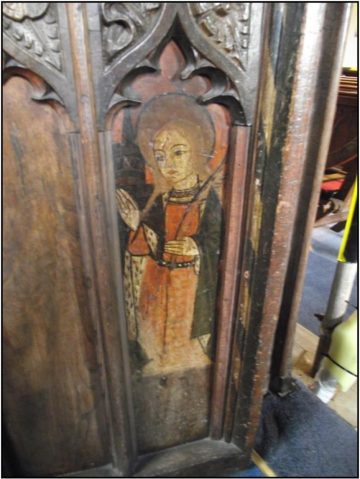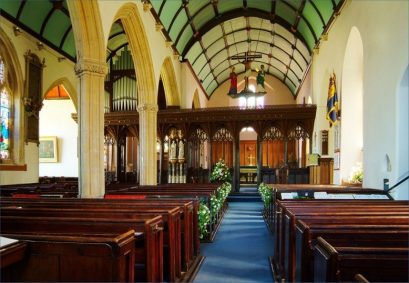This church is one of the most ornate in the North Devon Coast AONB, and hosts a fine, rare medieval rood screen currently benefiting from a major restoration project. Combe Martin’s parish church dates from the 13th century, although it may indeed sit on the site of an earlier Norman church a few hundred years earlier. Its situation in the village is likely to have been a medieval centre for the area. Many alterations took place during the 15th century, and the fortunes of the Combe Martin silver mines may well have contributed to the high level of craftsmanship, beauty and elegance of this historic building.
The stairs which formally led to the rood loft were reopened during the 1920s, having been blocked when the loft was taken out of use. It is possible to discern the remains of these stairs in many of the AONBs churches, suggesting they once also had impressive chancel screens.
See the Resources section to the right of this page for the St Peter Ad Vincula chapter of recent thesis of local historic churches by Historian Jamie Barnes. See below for short extract about the churches interior, which beautifully illustrates how our churches can transport us back in time…
“Combe Martin parish church retains its chancel screen, which is one of only two remaining in the parish churches of the AONB on this scale. Prior to the abandonment of High Church symbolism, the top of the screen contained a rood loft. This would have been used on holy days, when worship was focussed upon a large carved image, often of the crucifixion. This was known as the rood. Few of these images survive throughout England, as they were a large and obvious target for the puritans, and in some cases Calvinists.
The screen contains twenty two panels in its lower quarter (the wainscoting). It is a fascinating reminder of how colourful and vibrant many churches would have been prior to the reformation, and the belief that the colour was symbolic of the high church, and subsequently removed…
The wainscoting contains painted Saints. Their style suggests they are fifteenth century. Quite why they survived the puritans can only be speculated upon. It is possible that they had become so heavily soiled by the candle smoke that would have been present in abundance, that they simply escaped the attention of those who wished to remove them. It could have been the parishioners of Combe Martin may not have been that thorough in introducing the low church into their building, as some may have wanted.
Whatever the reason a remarkable survivor of the pre reformation period has been left, which visitors to the AONB may wish to enjoy. The extensive cleaning and restoration taking place at the time of writing, can only increase the enjoyment of all the aspects this screen has to offer, preserving its structure and features for future generations.
Combe Martin gives us a glimpse of how the interior of a church appeared prior to the introduction of plain ‘low church’ worship. The base of the pillar which dissects the chancel screen, displays a small area of dark green paint decorated with floral images. This would have been inspiring and impressive if applied to large areas of the church.”
The church is open from about March to October every day from about 10am to 4pm. If you would like to visit the church during the day when it is closed, then there are a list of people to contact (on the church door) who may be available to unlock the door. If you do have an opportuntity to visit, it is well worth the effort.




